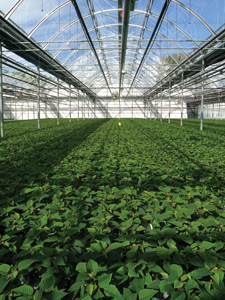5/15/2010
Planning Your Poinsettia Crop
Dr. P. Allen Hammer

Although some of you think poinsettias are hard to grow, I believe the new poinsettia cultivars available today make poinsettia growing fairly easy—that is, if you pay close attention to the details specific to individual cultivars. The difficulty often occurs when growers want to grow multiple cultivars all the same.
We also fall into the trap of “over-growing” the poinsettia crop; We think the crop is going to finish too tall, so we apply a PGR; or we think the crop is going to be too short, so we apply a PGR.
I know I always say to “look at the crop” and determine what the crop will look like in a week if you do nothing. But I also say that those weekly decisions, particularly for poinsettias, should be based on real data from your greenhouse, taking into account the difference in sunlight between years.
So the very first step in planning your 2010 poinsettia crop is to review your height and production data from past years. Summarize all that data into a form that you can use to make informed decisions in producing your poinsettia crop this year. Your very best poinsettia production guide for 2010 lies in the data you’ve collected in your greenhouse. You can also use the following points to help in organizing and planning your 2010 poinsettia crop:
Schedule
Scheduling starts with when the crop will be sold. From the selling date, you can determine when short days should start, when the plants should be pinched, and when liners should be planted or cuttings stuck. Scheduling must also take into account the pot size, finished height desired, the growing characteristics of the specific cultivar, and the finishing temperature (cool or warm finish). Proper scheduling of a poinsettia crop reduces the need for PGRs to either slow down a too-tall or speed up a too-short crop.
Planning decisions:
• Sale (flower) date
• (Response group, short days to flowering*)
• When short days start
• Pinch date
• Pot date
• Stick date
*Make sure you understand the response group of a cultivar under both blackcloth and natural days, as this is sometimes confusing.
Ordering
Hopefully, you’ve already ordered your plant inputs by now. Early ordering has become increasingly important, as our industry has reduced speculation in both cuttings and liners. Certainly an important decision is determining which starting point makes the most economic sense in your poinsettia production scheme. The decision isn’t obvious and must be made by careful analysis with pencil and paper. Don’t assume pre-finished plants return less profit because the input costs are higher.
Ordering production inputs
Now is the time to order pots, root media, fertilizer and production chemicals. Make sure your root medium and fertilizer is appropriate for the crop. Remember, poinsettias need additional calcium and molybdenum compared to some of the other crops you grow.
Selecting the growing container for poinsettias has also changed in recent years. Poinsettias have traditionally been grown in azalea (3/4-height) pots as a way to compensate for overly vigorous plants. With the newer, more compact cultivars, growers can select taller pots that better fit production and scheduling of the poinsettia crop.
Planning production space
Make sure you plan adequate space for propagation and production. Know where the poinsettia crop will be each day. A week of too-close spacing will affect finished plant quality. It’s often better to discard extra liners and plants than to squeeze those extra plants into already planned space.
Preparing production space
Clean and sterilize the propagation and production areas. Clean and sterilize all the greenhouse equipment, including the carts used for moving cuttings, liners and pots. Make sure your mist nozzles and mist controllers are working properly. Now is a good time to calibrate the injectors to make sure they’re working properly. And maybe an acid wash would help restore the uniformity of all those watering drippers.
Finally, make sure you’re prepared to provide adequate light levels and temperature for propagation. Shading is most often required during poinsettia rooting, but bottom heat can also be essential on cool nights even in August.
GT
Dr. P. Allen Hammer is a retired professor of floriculture at Purdue University, West Lafayette, Indiana, and is now in product development and support for Dümmen USA.